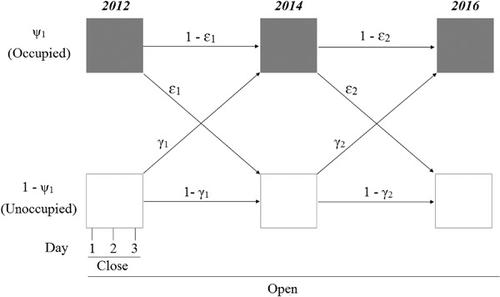当前位置:
X-MOL 学术
›
Am. J. Primatol.
›
论文详情
Our official English website, www.x-mol.net, welcomes your
feedback! (Note: you will need to create a separate account there.)
Monitoring occurrence, extinction, and colonization probabilities for gibbon populations.
American Journal of Primatology ( IF 2.0 ) Pub Date : 2020-07-07 , DOI: 10.1002/ajp.23171 Thinh T Vu 1 , Nguyen Q Hoa Anh 2 , Benjamin M Rawson 2 , Dung V Tran 1 , Hoa T Nguyen 1 , Thinh N Van 2
American Journal of Primatology ( IF 2.0 ) Pub Date : 2020-07-07 , DOI: 10.1002/ajp.23171 Thinh T Vu 1 , Nguyen Q Hoa Anh 2 , Benjamin M Rawson 2 , Dung V Tran 1 , Hoa T Nguyen 1 , Thinh N Van 2
Affiliation

|
All gibbon species (Family: Hylobatidae) are considered threatened with extinction and recognized on the International Union for Conservation of Nature Red List of Threatened Species. Because gibbons are one of the most threatened families of primates, monitoring their status is now critically important. Long‐term monitoring programs applying occupancy approaches, in addition to assessing occurrence probability, improves understanding of other population parameters such as site extinction or colonization probabilities, which elucidate temporal and spatial changes and are therefore important for guiding conservation efforts. In this study, we used multiple season occupancy models to monitor occurrence, extinction, and colonization probabilities for northern yellow‐cheeked crested gibbon Nomascus annamensis in three adjacent protected areas in the Central Annamites mountain range, Vietnam. We collected data at 30 listening posts in 2012, 2014, and 2016 using the auditory point count method. Occurrence probabilities were highest in 2012 (0.74, confidence interval [CI]: 0.56–0.87) but slightly lower in 2014 (0.66, CI: 0.51–0.79) and 2016 (0.67, CI: 0.49–0.81). Extinction probabilities during the 2012–2014 and 2014–2016 intervals were 0.26 (0.14–0.44) and 0.25 (0.12–0.44), respectively. Colonization probabilities during 2012–2014 were 0.44 (0.19–0.73) and between 2014 and 2016 was 0.51 (0.26–0.75). Although local site extinctions have occurred, high recolonization probability helped to replenish the unoccupied sites and kept the occurrence probability stable. Long‐term monitoring programs which use occurrence probability alone might not fully reveal the true dynamics of gibbon populations. We strongly recommend including multiple season occupancy models to monitor occurrence, extinction, and colonization probabilities in long‐term gibbon monitoring programs.
中文翻译:

监测长臂猿种群的发生,灭绝和定植概率。
所有长臂猿物种(科:Hylobatidae)都被认为濒临灭绝,并在国际自然保护联盟濒危物种红色名录中得到认可。由于长臂猿是最受威胁的灵长类动物之一,因此监视它们的状态现在至关重要。除了评估发生概率外,采用居住法的长期监测计划还可以增进人们对其他种群参数的了解,例如遗址的灭绝或殖民化概率,这可以阐明时空变化,因此对于指导保护工作也很重要。在这项研究中,我们使用了多个季节占用模型来监测北部黄颊凤头长臂猿的发生,灭绝和定植概率安南曲霉在越南中部安纳米特斯山脉的三个相邻保护区中。我们使用听觉点数方法收集了2012年,2014年和2016年的30个收听帖子的数据。2012年的发生概率最高(0.74,置信区间[CI]:0.56-0.87),但在2014年(0.66,CI:0.51-0.79)和2016年(0.67,CI:0.49-0.81)略有降低。在2012–2014年和2014–2016年间隔内的灭绝概率分别为0.26(0.14-0.44)和0.25(0.12-0.44)。2012-2014年期间的定殖概率为0.44(0.19-0.73),2014年至2016年之间的定殖概率为0.51(0.26-0.75)。尽管发生了局部灭绝,但较高的重新定殖概率有助于补充空置的位置,并使发生概率保持稳定。仅使用发生概率的长期监测程序可能无法完全揭示长臂猿种群的真实动态。我们强烈建议在长期的长臂猿监测程序中包括多个季节占用模型,以监测事件的发生,灭绝和定植的概率。
更新日期:2020-08-26
中文翻译:

监测长臂猿种群的发生,灭绝和定植概率。
所有长臂猿物种(科:Hylobatidae)都被认为濒临灭绝,并在国际自然保护联盟濒危物种红色名录中得到认可。由于长臂猿是最受威胁的灵长类动物之一,因此监视它们的状态现在至关重要。除了评估发生概率外,采用居住法的长期监测计划还可以增进人们对其他种群参数的了解,例如遗址的灭绝或殖民化概率,这可以阐明时空变化,因此对于指导保护工作也很重要。在这项研究中,我们使用了多个季节占用模型来监测北部黄颊凤头长臂猿的发生,灭绝和定植概率安南曲霉在越南中部安纳米特斯山脉的三个相邻保护区中。我们使用听觉点数方法收集了2012年,2014年和2016年的30个收听帖子的数据。2012年的发生概率最高(0.74,置信区间[CI]:0.56-0.87),但在2014年(0.66,CI:0.51-0.79)和2016年(0.67,CI:0.49-0.81)略有降低。在2012–2014年和2014–2016年间隔内的灭绝概率分别为0.26(0.14-0.44)和0.25(0.12-0.44)。2012-2014年期间的定殖概率为0.44(0.19-0.73),2014年至2016年之间的定殖概率为0.51(0.26-0.75)。尽管发生了局部灭绝,但较高的重新定殖概率有助于补充空置的位置,并使发生概率保持稳定。仅使用发生概率的长期监测程序可能无法完全揭示长臂猿种群的真实动态。我们强烈建议在长期的长臂猿监测程序中包括多个季节占用模型,以监测事件的发生,灭绝和定植的概率。











































 京公网安备 11010802027423号
京公网安备 11010802027423号